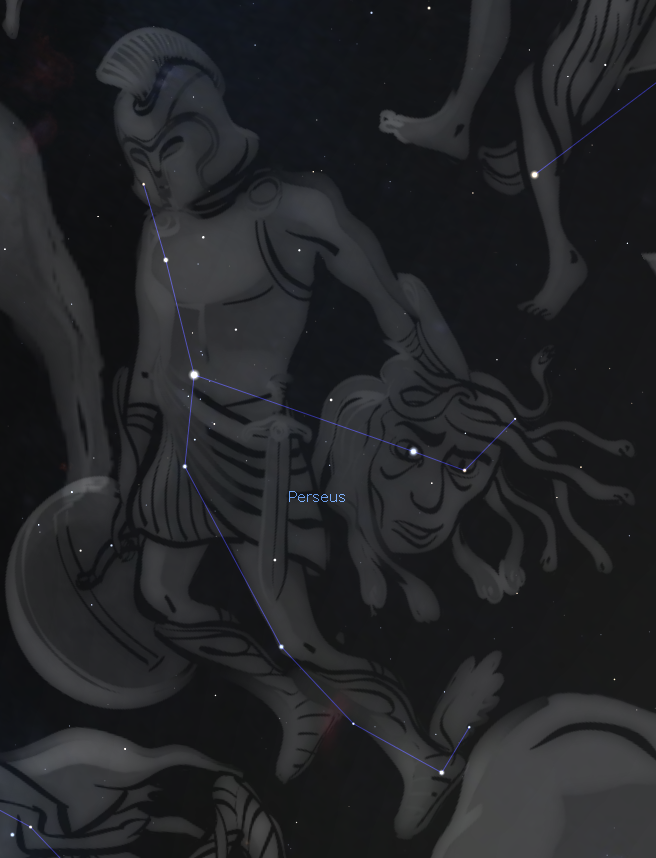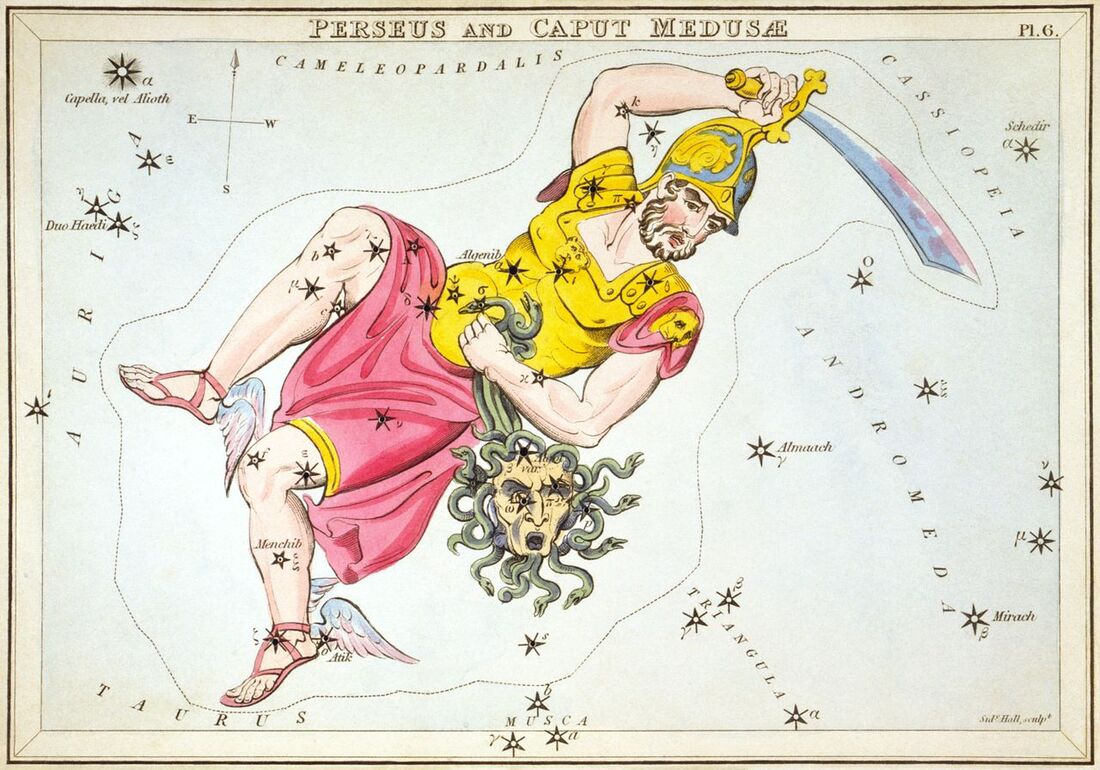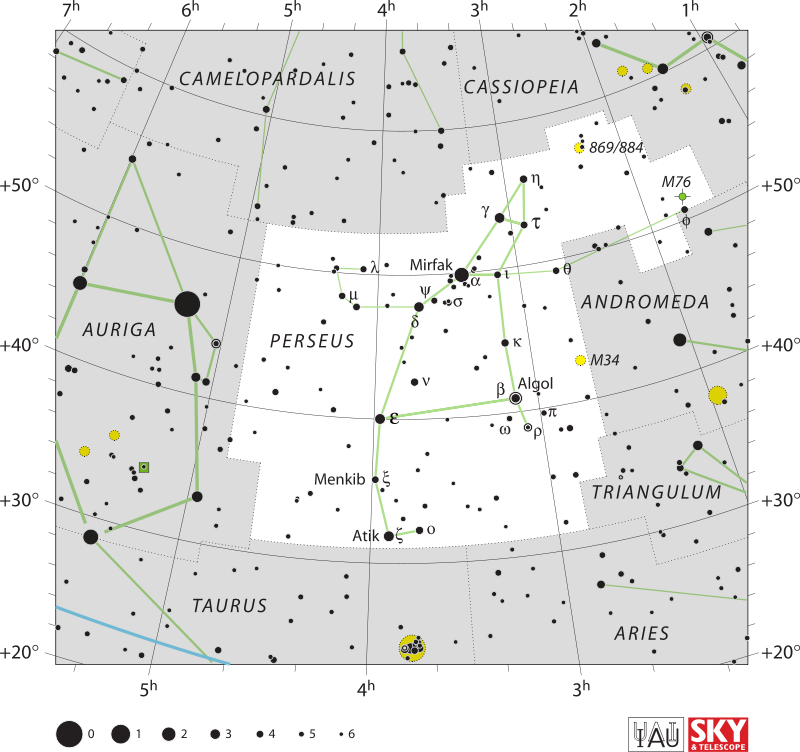|
The constellation Perseus is in the northern hemisphere and is named for the Perseus of Greek mythology. It is one of the eighty-eight contemporary constellations recognised by the International Astronomical Union and one of the forty-eight ancient constellations named by the 2nd-century astronomer Claudius Ptolemy (Graßhoff 2005) (IAU). It is situated close to three other constellations, Andromeda to the west and Cassiopeia to the north, which was given their names from Perseus-related myths in ancient Greek literature. Aries and Taurus to the south, Auriga to the east, Camelopardalis to the north, and Triangulum to the west all encircle Perseus. The asterism Perseus et Caput Medusae, which was titled along with the image of Perseus clutching the severed head of Medusa in several early 19th-century star atlases, was never adopted by the general public.
The yellow-white supergiant star Alpha Persei (also known as Mirfak), which glows at magnitude 1.79, is the brightest star in Perseus, which is traversed by the galactic plane of the Milky Way. It is a part of the Alpha Persei Cluster, an open cluster that includes many of the nearby stars. Algol (Beta Persei), the most well-known star, is however associated with frightening legends due to its fluctuation, which is visible to the unaided eye. It is an eclipsing binary, not an inherently variable star. Other prominent star systems in Perseus include GK Persei, a nova that peaked at brightness 0.2 in 1901, and X Persei, a binary system with a neutron star. The ancient Chinese were aware of the Double Cluster, which is two open clusters in the sky that are fairly close to one another. The Perseus cluster (Abell 426), a large galaxy cluster 250 million light-years from Earth, receives its name from the constellation. One of the most well-known meteor showers in the sky is the annual Perseids meteor shower. |
|
History and Mythology
Perseus was the son of Dana in Greek mythology, who was dispatched by King Polydectes to deliver the head of Medusa the Gorgon, whose face turned everyone who looked at it into stone. In her slumber, Medusa was killed by Perseus, and Chrysaor and Pegasus emerged from her corpse. In the kingdom of Cepheus, whose daughter Andromeda was to be offered as a sacrifice to Cetus the sea monster, Perseus continued his journey. By using his sword to kill the monster, Perseus was able to save Andromeda from it. He made Dictys the fisherman king and used Medusa's head to turn Polydectes and his adherents to stone. Six kids were born to Perseus and Andromeda after their union. The constellations Andromeda, Cepheus, Cassiopeia (Andromeda's mother), Cetus, and Pegasus are all close to Perseus in the sky. The constellation of Perseus was first referred to as the Old Man constellation (SU.GI) in Neo-Assyrian Babylonia (911-605 BC) and was later associated with the East in the 7th-century astronomical treatise MUL.APIN. (Dalley 1998) The area of the sky where Perseus is located in the west contains four Chinese constellations. Tiānchuán (天船), the Celestial Boat, was the third paranatellon of the third house of the White Tiger of the West, signifying the boats that Chinese people were urged to construct in case of a disastrous flood season. It included stars from the northern portion of the constellation, including Eta Persei, Mu, Delta, Psi, Alpha, and Gamma. The fourth paranatellon of the aforementioned house, Jīshuǐ (積水), the Swollen Waters, denoted the potential for abnormally high floods between the end of August and the start of September at the start of the flood season. Lambda. The fifth paranatellon of that building was Dàlíng (大陵), the Great Trench, and it represented the trenches where the bodies of offenders who had been executed in bulk in August were deposited. Kappa, Omega, Rho, 24, 17 and 15 Persei joined forces to construct it. Jīshī (積屍, Pi Persei), the sixth paranatellon of the house, symbolised the heap of bodies before their burial. In Chinese astronomy, the Double Cluster, also known as h and Chi Persei, held special significance. The only Polynesians who gave the constellation a name was those from the Society Islands; they called it Faa-iti, which translates to "Little Valley," and Perseus was not acknowledged as a distinct constellation in Polynesia. (Makemson 1941) The Maori people may have given Algol the name Matohi, however, there is conflicting evidence to support this claim. When Matohi ("Split") and Tangaroa-whakapau disagreed about which of them should show in the sky, the result had an impact on the tides. It resembles the blue-white star described by Maoris as being close to Aldebaran but does not vanish as the legend would have it. (Makemson 1941) |
Characteristics
From the south, Perseus is bounded by Aries and Taurus; from the east, Auriga; from the north, Camelopardalis, and Cassiopeia; and from the west, Andromeda, and Triangulum. It is the twenty-fourth largest constellation among the eighty-eight, with a surface area of 615 square degrees. The Northern Hemisphere's springtime sees it brightly in the northern sky. Nineteen stars make up its primary asterism. The Belgian astronomer Eugène Delporte established the borders of the constellation in 1930, and they are represented by a 26-sided polygon. These borders have right ascension values between 01h 29m and 04h 51.2m in the equatorial coordinate system, and declination coordinates between 30.92° and 59.11°. The constellation's three-letter acronym, "Per" was approved by the International Astronomical Union (IAU) in 1922. (Russell 1922)
From the south, Perseus is bounded by Aries and Taurus; from the east, Auriga; from the north, Camelopardalis, and Cassiopeia; and from the west, Andromeda, and Triangulum. It is the twenty-fourth largest constellation among the eighty-eight, with a surface area of 615 square degrees. The Northern Hemisphere's springtime sees it brightly in the northern sky. Nineteen stars make up its primary asterism. The Belgian astronomer Eugène Delporte established the borders of the constellation in 1930, and they are represented by a 26-sided polygon. These borders have right ascension values between 01h 29m and 04h 51.2m in the equatorial coordinate system, and declination coordinates between 30.92° and 59.11°. The constellation's three-letter acronym, "Per" was approved by the International Astronomical Union (IAU) in 1922. (Russell 1922)
Deep-sky Objects
- NGC 869 – Open Cluster
- NGC 884 – Open Cluster (this and the one above is known as the Double Cluster)
- Messier 34 (M34) – Open Cluster
- Messier 76 (M76) – Planetary Nebula
- NGC 1499 – California Nebula – Emission Nebula
- NGC 1333 – Reflection Nebula
- NGC 1023 – Barred Spiral Galaxy
- NGC 1260 – Spiral/ Lenticular Galaxy
- NGC 1275 – Type 1.5 Seyfert Galaxy
Main stars - 19
Bayer stars - 65
Stars with planets - 7
Stars brighter than Magnitude 3.00 - 5
Stars within 32 Ly - 0
Messier objects - 2
Meteor showers
Bordering
constellations
Bayer stars - 65
Stars with planets - 7
Stars brighter than Magnitude 3.00 - 5
Stars within 32 Ly - 0
Messier objects - 2
Meteor showers
- Perseids – Mid-July to mid/late August – Peak early August
- September Perseids
Bordering
constellations
- Aries
- Taurus
- Auriga
- Camelopardalis
- Cassiopeia
- Andromeda
- Triangulum


